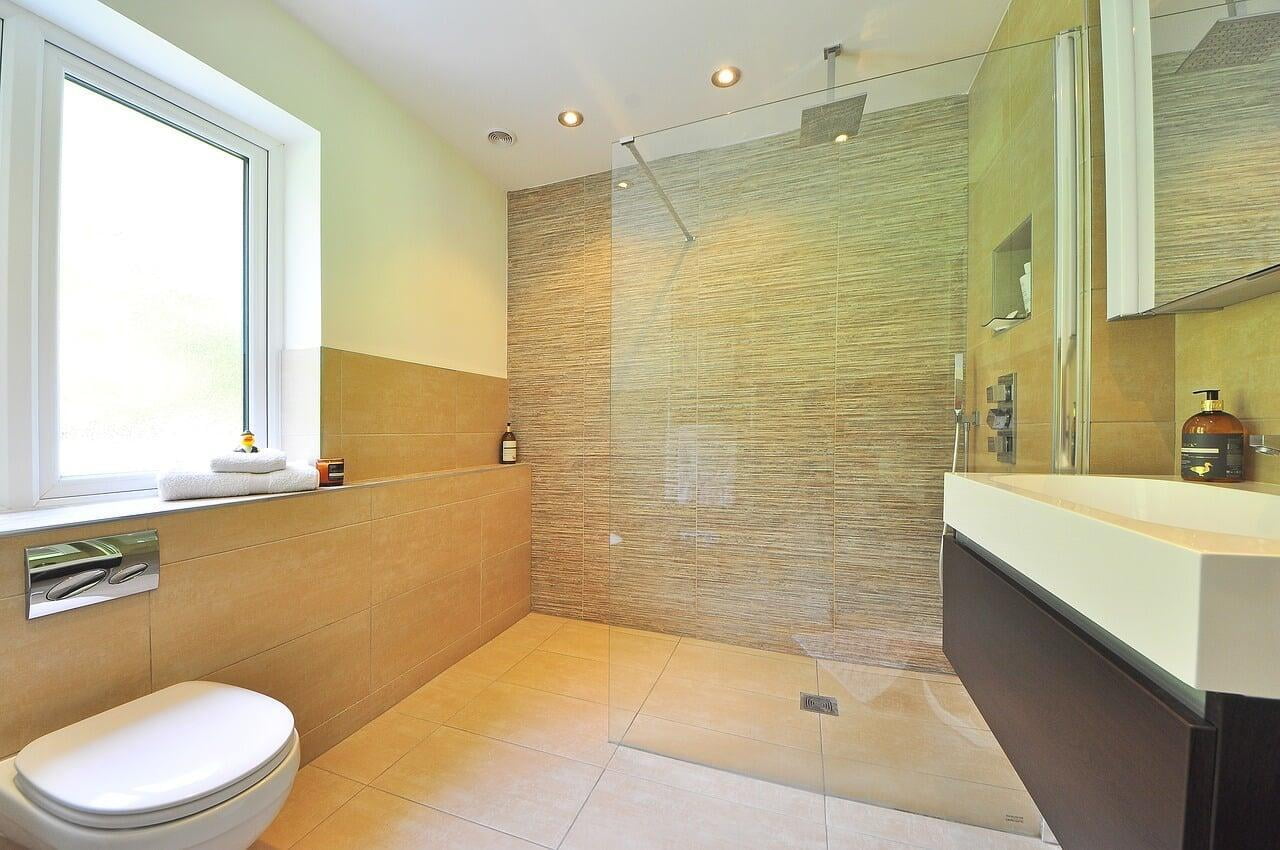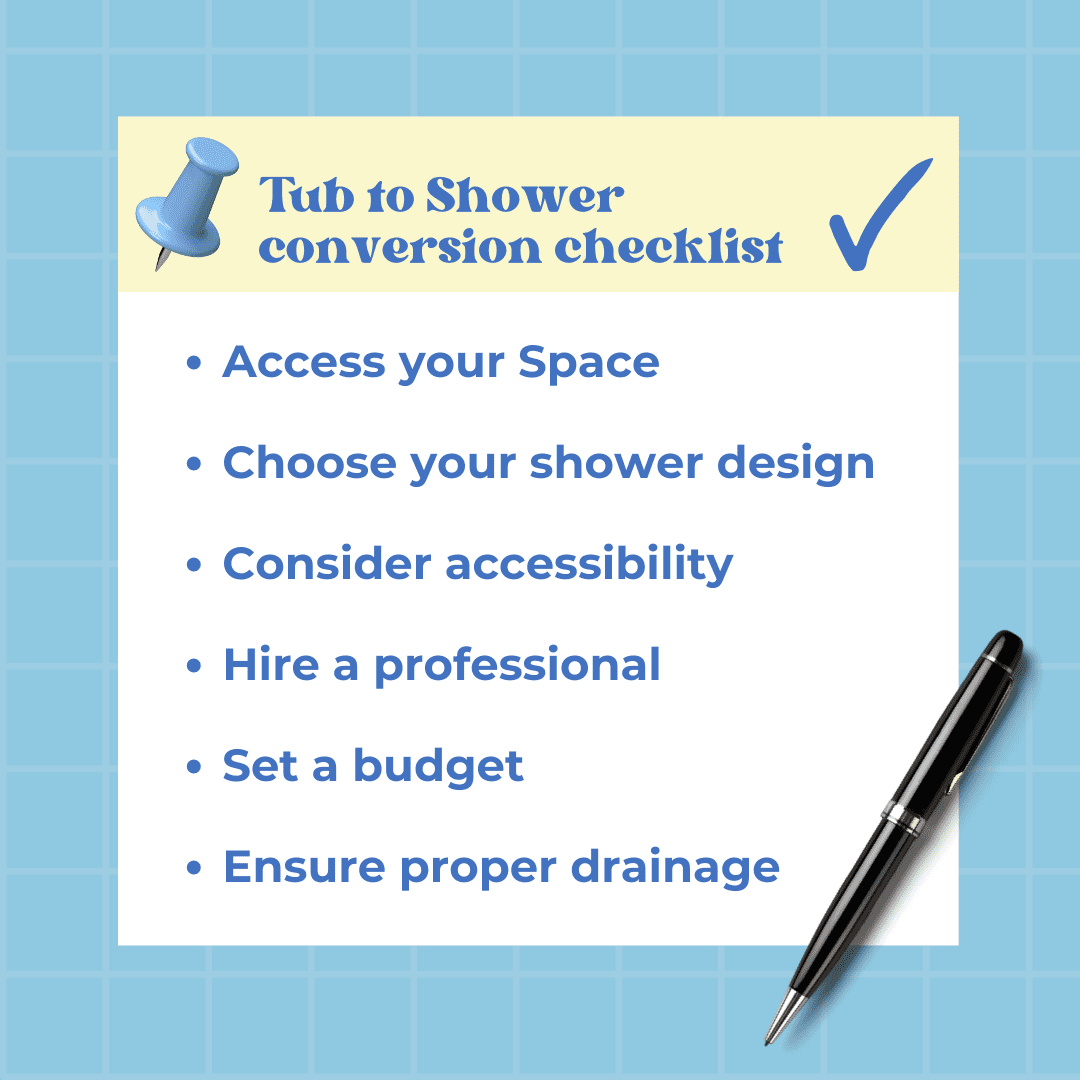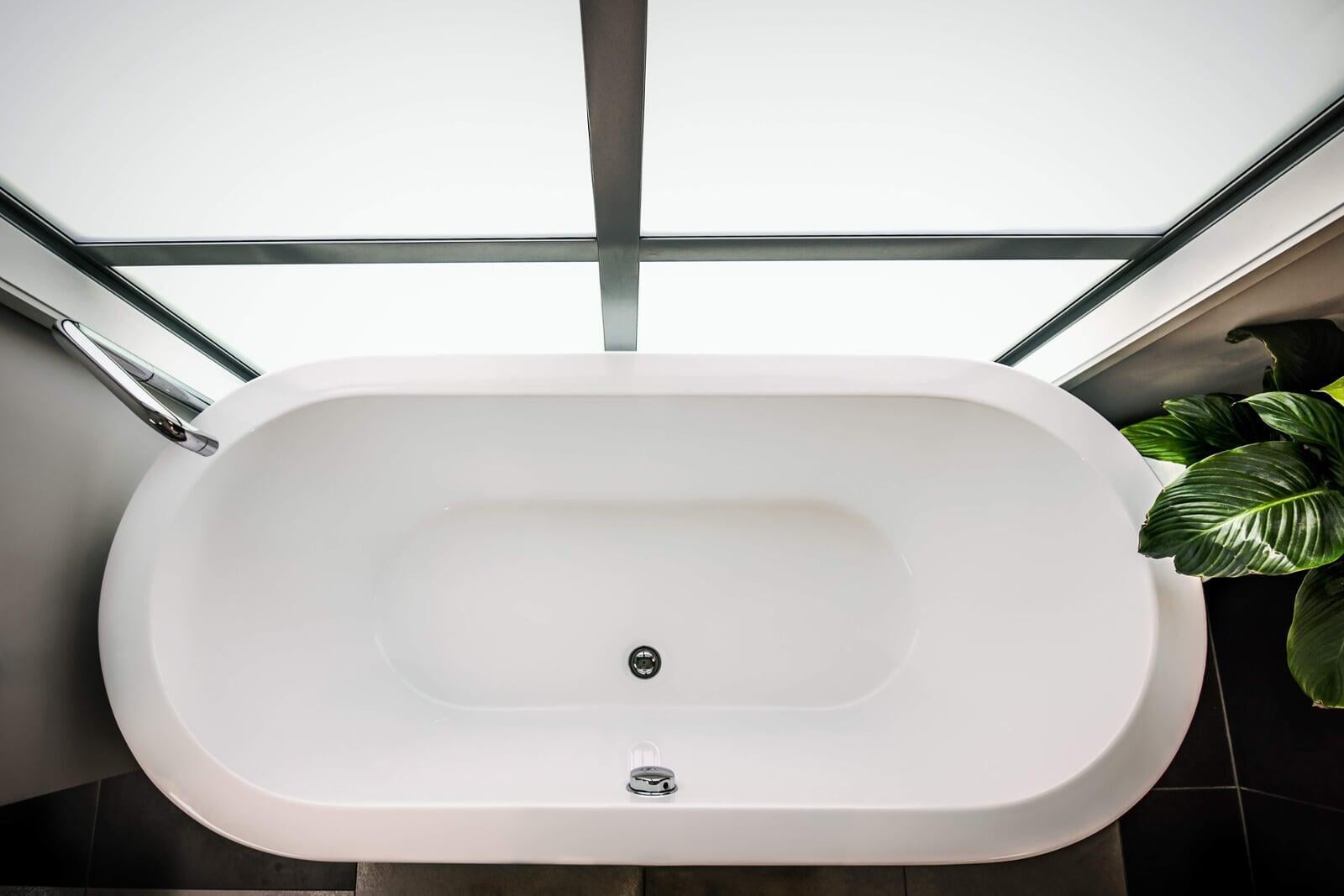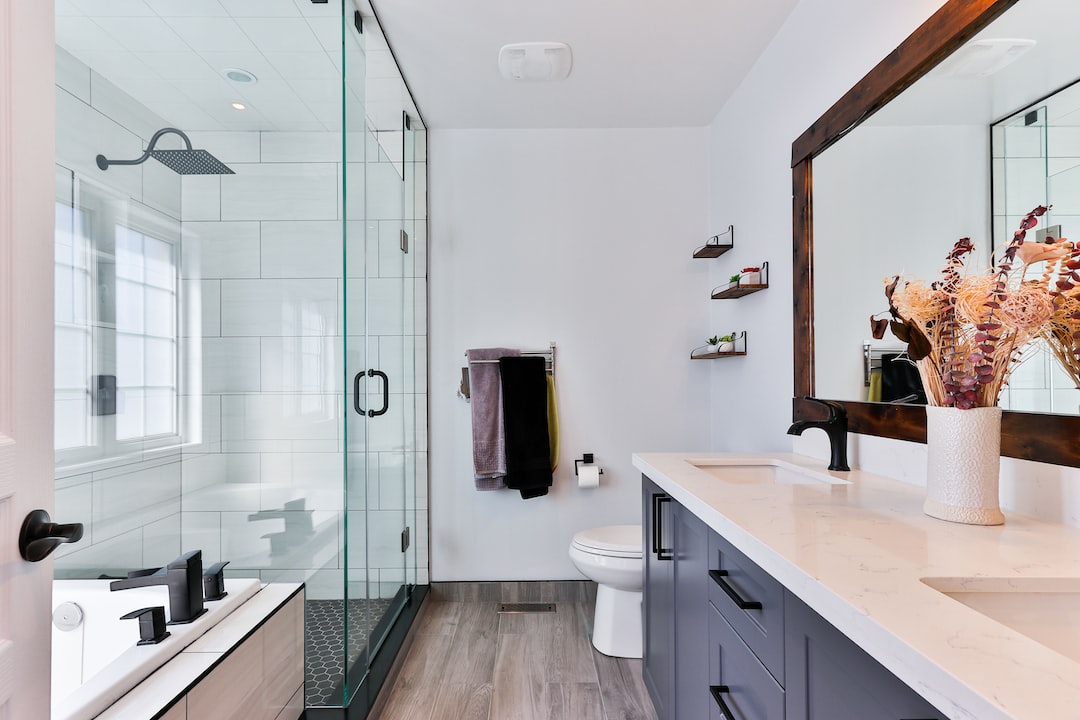
Transforming your bathroom can be an exciting endeavor, and if you're considering upgrading to a more efficient and contemporary option, then a tub-to-shower conversion might be the perfect solution.
In today's fast-paced world, where time is a precious commodity, the convenience and practicality of a shower have become increasingly appealing to homeowners. Gone are the days when leisurely soaking in a bathtub was a frequent indulgence. With our busy lives filled with personal and professional commitments, showers offer a quick and rejuvenating alternative, aligning perfectly with the modern, on-the-go lifestyle.
This guide offers step-by-step directions and highlights the benefits of switching from a tub to a shower for an improved appearance. Read on for everything you need to know about converting your old tub into the perfect bathing spot!
Steps and Tips to Consider Before Undertaking a Tub to Shower Conversion
Steps and Tips to Consider Before Undertaking a Tub to Shower Conversion

Assess your space: Measure the available space to determine the size and layout of the new shower. Remember, you'll need adequate space not just for the shower, but also for a comfortable getting in and out.
Choose your shower design: There is a vast array of shower design options to suit every taste and home style. Consider factors such as the type of shower (e.g. standalone, walk in shower), the material (e.g. tile, acrylic), and the shower hardware (e.g. chrome, brushed nickel). You may also want to think about including a built-in seating area for comfort and accessibility, or a steam feature for added luxury. Be sure to choose a design that's not only visually appealing, but also practical and durable for everyday use.
Consider accessibility: If you or a family member has mobility issues, consider incorporating features like a zero-threshold shower base, grab bars, or a built-in bench for added safety and comfort.
Hire a professional: Unless you're an experienced DIYer, it's best to hire a professional for the job to ensure the plumbing, waterproofing, and the overall installation process is done correctly.
Set a budget: Tub to shower conversions can vary in price depending on the materials used and the complexity of the job. So, it's important to set a realistic budget before you begin.
Ensure proper drainage: Make sure your new shower has appropriate slope and drainage to prevent any water leakage or damage in the future. You can opt for a standalone shower stall or go for a seamless, walk-in design with glass shower door.
Steps to Convert Your Tub into a Shower
Steps to Convert Your Tub into a Shower

Step 1: Remove the Old Bathtub
Step 1: Remove the Old Bathtub
To remove the old bathtub, start by turning off the water supply. Then, take out the faucet and fixtures. Use a utility knife to cut through the caulk around the tub. You may need a pry bar to lift it out. Be careful not to damage the floor and walls. Once the tub is out, clean up any debris and caulk.
Step 2: Prepare the Area for Your Shower
Step 2: Prepare the Area for Your Shower
Accurately measure the space to ensure a perfect fit. Plan the locations for your shower fixtures and mark the wall accordingly. Check and adjust the plumbing if needed. Ensure level floors and sturdy, waterproofed walls around the shower area. For new tiles, install backer boards on walls and floor.
Step 3: Install the Shower Base
Step 3: Install the Shower Base
Next, install the shower base (also known as the shower pan). Place it in the designated area, ensuring a perfect fit. Use a spirit level to check for levelness. Once confirmed, mark its position. Remove the base and apply mortar to the floor. Then, place the base back onto the mortar, aligning it with your marks. Apply pressure to secure it. Fasten the base to the wall studs following the manufacturer's instructions. Allow the mortar to dry before proceeding.
Step 4: Install the Shower Walls
Step 4: Install the Shower Walls
Once the shower base is securely installed and the mortar has dried, it's time to install the shower walls. Start by dry fitting the wall panels to ensure a correct fit. Apply adhesive to the backer boards or panels, following the manufacturer's instructions. Press the panels onto the adhesive, holding them in place until secure. Use a level to ensure straightness. Install necessary fixtures, like a showerhead or grab bars, as instructed. Once the adhesive dries, caulk the seams between the panels and base for a waterproof seal. Allow the caulk to dry fully before proceeding.
Step 5: Install the Shower Door
Step 5: Install the Shower Door
After securely placing and sealing your walls, the next step is installing the shower door. Measure the opening to ensure a precise fit. Follow the manufacturer's instructions to assemble the door frame and panels. Once assembled, place the door into the opening, ensuring it's level. Use shims if needed for adjustment. Secure the door by screwing it into the wall studs. Apply silicone caulk around the frame edges to create a watertight seal. Finally, install the door handles and hardware as instructed. Allow the caulk to dry completely before using the shower.
Step 6: Final Checking and Cleaning
Step 6: Final Checking and Cleaning
Start by carefully inspecting the entire setup. Make sure all fixtures are secure and the door opens and closes smoothly. Check that all seals are watertight and the shower drains properly. If you find any issues, address them immediately. Once you're satisfied with the inspection, clean the entire shower area. Remove any excess caulk, adhesive, or debris, and clean the glass door and wall panels following the manufacturer's instructions. After cleaning, let the shower sit unused for at least 24 hours to ensure everything is dry and secure.
Estimated timeline for the project
Estimated timeline for the project
The estimated timeline for a bathtub to shower conversion can vary based on factors such as job complexity, existing plumbing condition, and shower type. Generally, the process takes around 1-2 weeks. However, keep in mind that your circumstances and chosen professionals can affect this timeframe. Allow extra time for unexpected issues or delays.
Dealing with potential challenges and permits
Dealing with potential challenges and permits
When dealing with potential challenges and permits, it's crucial to have a detailed plan and knowledge about local building codes. Certain modifications, like the ones related to plumbing or electric systems, often need approval from local authorities.
It's recommended to consult with a professional contractor who can guide you through the permit process and ensure all changes adhere to safety standards. In case of unforeseen issues, such as structural damage or outdated wiring, have a contingency plan in place. This includes setting aside additional funds and time to address these complications without compromising the project's quality and safety.
Benefits of Tub to Shower Conversion
Benefits of Tub to Shower Conversion

Improved Functionality and Space Utilization
Improved Functionality and Space Utilization
Make sure your new shower has appropriate slope and drainage to prevent any water leakage or damage in the future. You can opt for a standalone shower stall or go for a seamless, walk-in design with glass shower door.
Enhanced Aesthetics and Modernization
Enhanced Aesthetics and Modernization
Switching from a tub to shower can often enhance the aesthetic appeal of your bathroom. Shower, especially those with frameless glass enclosures, tend to offer a sleek and modern look that can bring an updated feel to your bathroom decor. Showers offer a range of customization options, such as using materials like ceramic tile, porcelain, or stone, and incorporating unique features like rain showerheads or built-in shelves.
Increased Accessibility for All Family Members
Increased Accessibility for All Family Members
Converting a tub into a shower is a proactive step to ensure bathroom accessibility and safety for all family members, including the elderly and those with disabilities. Showers, especially walk-in designs, offer a barrier-free entry, reducing the risk of slipping and falling when stepping over a bathtub rim.
Potential Increase in Property Value and ROI
Potential Increase in Property Value and ROI
Remodeling a bathroom, particularly with a tub-to-shower conversion, can significantly boost a property's value and provide a substantial return on investment (ROI). Modern homebuyers often favor homes with aesthetically pleasing, functional showers over traditional bathtubs.
According to real estate experts, a well-executed bathroom renovation can recoup anywhere from 60% to 70% of the investment, making it a worthwhile endeavor for homeowners.
It's important to note, however, that the exact ROI will depend on various factors, including the quality of the renovation, the home's location, and current market trends.
Average Cost of Tub to Shower Conversion
Average Cost of Tub to Shower Conversion
The cost of converting a tub to a shower can vary depending on factors such as the materials used, project complexity, and labor costs in your area. According to Home Depot, this type of conversion typically ranges from $6,000 to $10,000, covering both materials and labor. It's important to note that your specific project may differ in cost, but this average serves as a useful point of reference.
Factors Influencing the Overall Cost
Factors Influencing the Overall Cost
- Material Choice: The selection of materials has a significant impact on the cost. High-end finishes such as natural stone or custom fixtures will be more expensive than standard options.
- Project Complexity: The complexity of the project influences the final price tag. For instance, moving plumbing fixtures or altering the bathroom layout can escalate costs due to the additional labor required.
- Geographical Location: Labor costs vary depending on the geographical location, with rates differing based on local market conditions.
- Unforeseen Issues: Unexpected issues that arise during the conversion, such as water damage or outdated plumbing, can result in additional expenses.
- Demolition Costs: The cost of demolishing and removing the existing bathtub may vary depending on the bathtub's size, material, and location.
- Plumbing Adjustments: Any necessary adjustments to the existing plumbing system to accommodate the new shower can add to the overall cost.
- Installation Costs: The cost of installing the new shower, which includes labor and any necessary adjustments, can significantly influence the total cost.
Professional vs. DIY Tub-to-Shower Conversion
DIY can be cost-effective and provide a sense of satisfaction. If you're adept at plumbing and tiling, the DIY approach might be viable. However, remember, a bathroom renovation is complex and requires precision to avoid issues like leaks or structural damage.
On the other hand, hiring a professional for bathroom remodeling ensures the job is done right the first time, which can help you save money for repair costs down the line.
Professionals have the requisite knowledge, experience, and tools to handle any unexpected issues that arise during the project. While it may cost more upfront, professional installation provides peace of mind regarding the project's quality and durability.
How to Minimize Tub-to-Shower Conversion Costs
There are several strategies you can employ to mitigate the cost of a tub-to-shower conversion, even when hiring professionals:
- Instead of opting for high-end materials and intricate designs, consider using standard fixtures and finishes. They are usually more cost-effective and equally functional.
- If possible, avoid altering the existing bathroom layout or moving plumbing fixtures.
- If you have some DIY skills, consider doing some of the lighter work yourself, such as removing the bathtub or painting the walls.
- Don’t settle for the first quote you get. Instead, consult several bathroom remodeler to compare prices and services before making a final decision.
- A well-thought-out plan can help avoid costly mistakes or changes during the conversion process, which can often lead to unanticipated expenses.
- Regular maintenance of your bathroom can help prevent unforeseen issues that could potentially increase the cost of the project, such as water damage or outdated plumbing.
Transforming your bathroom with a tub-to-shower conversion offers numerous benefits, catering to the fast-paced lifestyle of today. Showers provide convenience and efficiency, making them an appealing choice for homeowners.
Hiring a professional for the job is recommended to ensure proper installation and avoid potential issues. For a successful transformation, consult experts in the field who can create a beautiful and functional shower tailored to your needs.
If you're ready to take the first step towards transforming your bathroom and performing a tub to shower conversion, our team at Redo Shower is here to help. We are dedicated to creating beautiful and functional shower spaces tailored to your unique needs.

